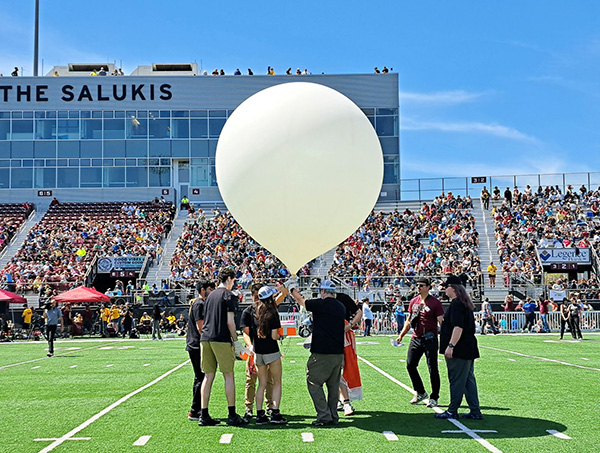
13 students and three faculty members from the College of Engineering, Technology and Architecture (CETA) headed into the path of totality to launch two high-altitude balloons: one from the campus of Southern Illinois University in Carbondale, Illinois, and a second balloon from Oak Ridge, Missouri.
The Carbondale balloon carried a student-built Geiger counter, ozone sensor, and other instruments to collect a wide range of atmospheric data. According to Paul Slaboch, Director of the Aerospace Engineering Program, who led the team, all the instruments worked as designed and were able to tell the students about solar radiation and temperature during totality of the eclipse.
The Oak Ridge balloon, meanwhile, ascended to an estimated 93,000 feet, and carried two sets of cameras that were able to capture the shadow of the moon as it moved across the face of the sun. This balloon also carried atmospheric sensors to record temperature, pressure, as well as GPS data that allow for estimates of the winds aloft.
The mission wasn’t without its challenges. The team wasn’t able to pick up a planned livestream from the Oak Ridge balloon, and lost the GPS tracking from the Carbondale balloon. “It was found by a woman in Kentucky in her backyard, who returned it to us,” Slaboch says. “It traveled more than 300 miles across three states.”
The launch was the culmination of more than a year’s work as part of the NASA-supported Nationwide Eclipse Ballooning Project, which brought together teams from educational institutions around the country.
Work started early in 2023 and continued with a test flight in May of that year. In October, the team traveled to Albuquerque, New Mexico to launch the balloon during the annular eclipse. They used what they learned to redesign the payload systems in preparation for the total eclipse. “This was a vast improvement from October,” Slaboch says.
For the April 8 launch, the UHart students teamed up with students from Tunxis Community College. They also worked with teams from Nebraska and Iowa State to troubleshoot the balloons before the launch. The ballooning project is supported by the NASA CT Space Grant Consortium in its effort to provide students with real-world, hands-on experiences that prepare them for their career paths and future research opportunities.
The students on the UHart team will contribute to NASA papers about the project. But in addition to the hard science involved, Slaboch says the project was an opportunity for students to learn "soft skills" that will serve them in the future: “Time management, team building, communicating across teams—how to keep tempers down when stress levels are high."
To view video taken by the Oak Ridge balloon, click here.